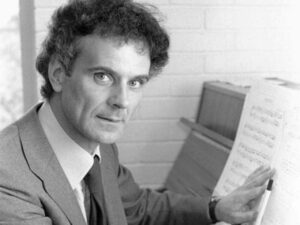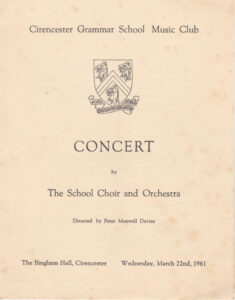
Webnote 2
Sir Peter Maxwell Davies – the Cirencester link
by David Viner

This article was first published in the June 2021 issue of Cirencester Scene community magazine, as a contribution to the Snapshots of Local History series co-ordinated by Cirencester Civic Society. It is reproduced by kind permission of the Editor. The author of this piece was also in his first year at the school when ‘Max’ arrived in 1959 and despite being ‘non-musical’ well remembers the musical excitements of the following three years in Cirencester.
When Peter Maxwell Davies died in 2016 at the age of 81, his reputation as one of the leading British composers of the 20th century was already well established, thanks to the prolific output from his long and very active working life and the musical controversies which went with it. He created over 300 works including concertos, no less than ten symphonies, plus operatic and music-theatre pieces. At various stages in his life, he was also involved in making music with school-children, not least during his three years teaching here in Cirencester from 1959-62.
‘Max’, as he was universally known, came from a working-class family background in Salford and held avowed republican sentiments; in this and in his music he remained non-conformist. Not surprisingly he was hardly an ‘establishment’ figure, despite ten busy and productive years from 2004 as Master of the Queen’s Music, the musical equivalent of poet laureate. Accolades came his way in recognition of the significance of his musical achievements. Knighted in 1987, his CBE from 1981 was raised to Companion of Honour in 2014.
For the final forty-plus years of his life, Maxwell Davies lived in Orkney, a love affair with Scotland’s northern isles which included a decade at least living in very remote circumstances on the island of Hoy, before moving even further to live finally on remote Sanday. This period included his stewardship and strong advocacy of the St Magnus Festival held annually in Kirkwall’s fine cathedral.
His musical compositions from these years are strongly resonant of this Scottish experience. Some of them, perhaps those now more ‘accessible’ in character, ensure that at least this part of his output surfaces regularly via today’s range of media options, and very welcome it is too – ‘An Orkney Wedding with Sunrise’ being one favourite, and ‘Farewell to Stromness’ another.
All this lay in the future when Max came as music teacher to Cirencester Grammar School in Victoria Road in 1959, a post which offered him some financial stability early in his career plus the chance to develop his own skills and widen the musical experience of his pupils. This he certainly did, and for those lucky enough to benefit from the experience it has remained a memorable time.
He simplified his style considerably to help his pupils, and various concerts by the Music Club duly followed, performed at the school or in the parish church. Musical boundaries were pushed for his pupils as well as his audience, setting the scene for so much of his subsequent career as a composer.
The most memorable was probably ‘O Magnum Mysterium’, a set of carols and instrumental pieces composed for the school, and reflecting Max’s love of historical church music. A concert in the church at Christmas 1961 presented the second of the Wakefield Shepherds’ Plays, a well-known ‘mystery’ play from the medieval period.

Max’s domain was the Music Room facing onto Victoria Road, which remains in use today as part of Cirencester Primary School. In between it was part of the town’s Junior School. When Anne Buffoni, now Chair of Cirencester Archaeological & Historical Society and then a teacher at the school, explained to her pupils why their classroom had a very wide door to allow for the movement of large musical instruments, she welcomed the chance to tell them about the school’s famous composer-teacher. Sharing his music followed and a group letter went off to Max in Orkney as a reminder of his Cirencester days.
What came back was a warm appreciation from him, which Anne treasures for posterity. ‘I enjoyed the children’s writing and drawing enormously’ said Max, who also clearly remembered the Bingham Hall Rifle Range used for rehearsals, and the recording of ‘O Magnum Mysterium’ there in 1961.
So it is wholly appropriate that the latest Cirencester Civic Society blue plaque should record the link between the town and its famous composer, placed appropriately on the outside wall of the music room which was at the heart of this story.
There are a number of publications on the significance of Max’s work over his long lifetime; one which gives a good focus to his Cirencester years is Max – the Life and Music of Peter Maxwell Davies by Mike Seabrook (Victor Gollanz, 1994).
July 2021
Picture credits:
Top: Public Domain
Middle: Programme for the 1961 Concert which included works by Monteverdi, Byrd and Palestrina with contributions from Max and pupils of the school (courtesy Richard Reece collection).

Bottom: Marking the erection of the plaque at the Victoria Road school are (left to right) Anne Buffoni (chair of Cirencester Archaeological & Historical Society), William Cooper (Vice-chair of Cirencester Civic Society) and David Viner (former chair of CAHS and the school’s final head boy in 1966, sporting his old school cap! Picture courtesy John Tiffney.